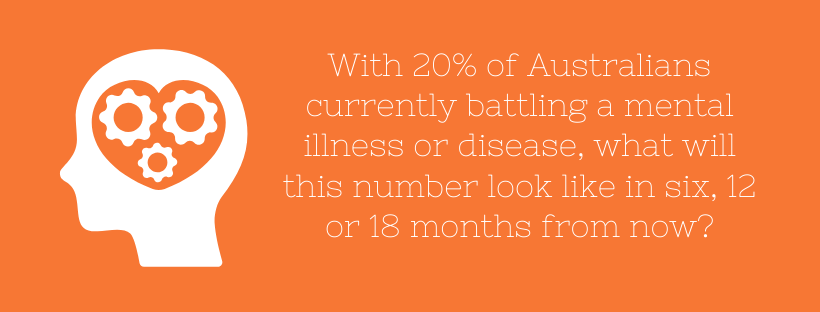Whilst hundreds of thousands of Australians are currently experiencing uncertainty and increased stress related to their employment status, financial security and health, there is no doubt that psychological injury rates will skyrocket in the coming months, and possibly even years to come. And regardless of employment status, industry or role, psychological injuries will not discriminate.
With 20% of Australians currently battling a mental illness or disease, what will this number look like in six, 12 or 18 months from now?
While employers may already take traditional steps to maintain positive mental health among their employees, with face-to-face contact now limited, recognising the symptoms of psychological injury, and consequently early intervention, is almost impossible unless the worker themselves speaks up.
Employers now more than ever need to take a proactive approach in recognising where potential psychological injuries may occur, and determine where the demands of work may exceed an individual’s ability to cope. Learn about the ‘mental health risks to isolated teams or people’ via our virtual training course.
Some examples of psychological hazards may include:
- Working from home arrangements – while individual home and family lives differ, risks can arise when faced with combining working from home and caring for young children, home-schooling, relationship strain, loneliness and isolation when living alone, or domestic violence.
- Poor organisational change management – with restructures inevitable for many businesses, lack of communication, information and support to workers may contribute to stress and uncertainty
- Experience of violence or aggression – particularly for people working within healthcare, supermarkets, pharmacies and medical practices, customers accessing these services may be hostile and act irrationally or aggressively causing concerns for the mental health of workers.
- Reduced or poor work environment – particularly when working from home or from temporary places, workers may be exposed to small or confined spaces, hot or cold, noisy or dark workplaces, which can contribute to anxiety and reduced comfort levels, as well as the potential for physical strain or injury.
- Reduced or minimal support – particularly for people working from home where they may not have the resources or access to their usual support networks, workers may experience an increase in anxiety and stress, as well as a potential decrease in efficiencies.
With countless work-related situations and circumstances now presenting the ability to trigger psychological injuries, it’s obvious that employers need to look beyond relationship-building activities and Employee Assistance Programs to prevent them.
Here are seven reconsidered tips to assist in managing and recognising stress:
- Employers and/or Managers should have a basic understanding of individual worker’s home and family situation, whilst respecting privacy, and consider these factors when managing workloads and offering support.
- Regularly communicate with workers, particularly as changes are made to job roles, the working environment, industry or individual roles, and ask them directly if there is anything specifically contributing to their stress or causing concern. Learn how to ‘maintain positive mental health culture in isolated teams’ via our virtual Zoom training course.
- Inform workers of their entitlements, responsibilities and changes to their role as soon as known. Give workers the opportunity to provide feedback and discuss concerns.
- Provide workers with a point of contact to discuss any stressors, particularly with regards to psychological health, and take the immediate steps necessary to manage accordingly.
- Be conscious of increased work demands, for example where a restructure has resulted in more work for certain employees, and proactively support them.
- Stay informed with information and resources from official channels, and regularly communicate these to staff, sharing relevant information which is specific to job roles and industry.
- Maintain traditional mental health support services and resources, such as Employee Assistance Programs, and regularly remind workers of their right to access these services. Work Options are offering a 10% on EAP Services – contact us for a quote.
For further information in how to support mental health in a work setting:
- SafeWork NSW –COVID-19 pandemic: mental health at work
- Comcare –Coronavirus: looking after your mental health
- Headspace – How to cope with stress related to coronavirus (COVID-19)

